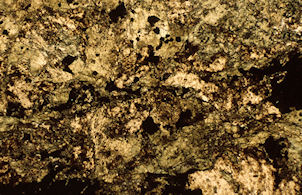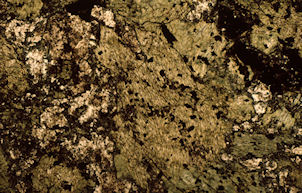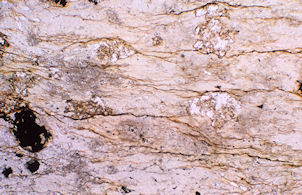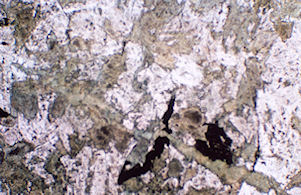
Figure 20: Group III-1 axe Wi110/393 in PPL and XPL (Field of View (FoV) is 4mm). Click image to enlarge
The two members of GpIII-1: Wi4/4 (IPG Group III founding member) and Wi110/393 contain once partly ophitic pyroxenes to 2mm across that have been totally replaced by acicular and occasionally feathery aggregates of amphibole, with bright, second order birefringence which suggests tremolite-actinolite or hornblende. These mm-sized mats of amphibole are surrounded and penetrated by fine granular patches of a very fine-grained mineral, possibly a clay or more likely mica such as sericite, after feldspar. Clear, high relief grains of clinozoisite (iron-free epidote) are also associated with the feldspar alteration. Small (<0.1mm) apatite grains are readily visible in the groundmass. Irregular, eroded opaques are surrounded by fine granular sphene/leucoxene.

Figure 20: Group III-1 axe Wi110/393 in PPL and XPL (Field of View (FoV) is 4mm). Click image to enlarge
Five Group III thin-sections: Co53/562, Do156/1784, So22/267, Wi199/648 and Wi205/687 forming GpIII-2 appear the same as GpIII-1 with the addition of distinct pale green patches made up from a mat of very fine granular and slightly coarser grains, both with first order birefringence, believed to be a combination of chlorite and amphibole after pyroxene.

Figure 21: Group III-2 axe Co53/562 in PPL and XPL (FoV 4mm). Click image to enlarge
The three GpIII-3 thin-sections: Do12/91, Do6/54, Wi42/137(IIIa) and 1993/81/A (no county number) are dominated by mats of fibrous to granular amphibole showing first order birefringence, with the occasional fibrous grain of second order tremolite-actinolite, probably after pyroxene. Rare feldspar and quartz is recognised in a fine-grained granular groundmass containing small amphibole and clay minerals. One, Dorset 12/91, shows alignment of grains. Apart from slight difference in texture and the presence of quartz GpIII-1 is similar to GpI-3.

Figure 22: Group III-3 axe Do6/54 in PPL and XPL (FoV 4mm). Click image to enlarge
The single member of GpIII-4, Co426/1884, is very fine grained with alignment of minerals and is different from the other IPG Group I, Ia, III and IIIa thin-sections examined. The groundmass is chloritic, fine, very pale brown (ppl) showing dark grey/black under crossed polars. Within the groundmass elongated grains of quartz and albite(?) are seen following the fabric of the section. Higher relief, granulated areas have bright second order birefringence and may be a combination of very fine granular biotite and muscovite mica, with the grain size making it difficult to confirm. There are relatively few sub <0.5mm opaques in the section.

Figure 23: Group III-4 axe Co426/1884 in PPL and XPL (FoV 4mm). Click image to enlarge
In thin-section Wi84/302 (IIIa), the only member of GpIII-5, the relatively unaltered, sub-mm, plagioclase feldspar contains small acicular actinolite and granular epidote. This, and bright, mid second order, amphiboles which have completely replaced the once non-ophitic sub-mm euhedral pyroxenes, make this thin-section similar to Group I-6 and different from any other thin-section assigned to Group III.

Figure 24: Group III-5 axe Wi84/302 in PPL and XPL (FoV 4mm). Click image to enlarge
© Internet Archaeology/Author(s) URL: http://intarch.ac.uk/journal/issue26/23/2.4.3.html
Last updated: Wed Jul 29 2009